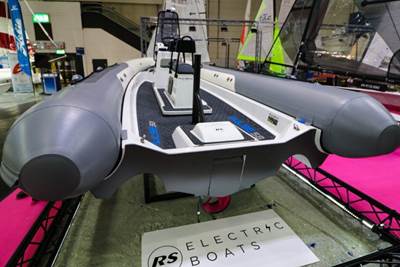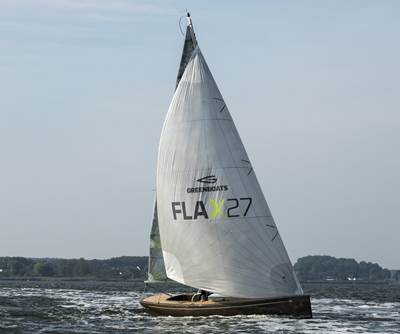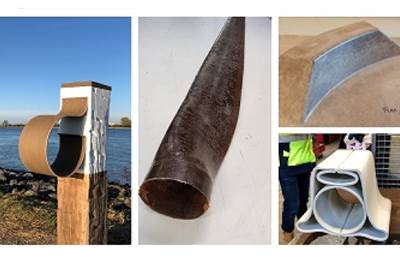Alliance for European Flax-Linen and Hemp reports increasing flax fiber adoption in marine
The natural fiber is increasing traction across several marine applications, including in projects by Greenboats, Northern Light Composites, the Beneteau Group and others.
Monitoring natural fiber developments, the Alliance for European Flax-Linen & Hemp (Paris, France) reports that the adoption of composite parts based on flax fibers by the marine industry continues to grow, with major OEMs as well as smaller shipyards now aiming to take advantage of the reduced carbon impact and optimized mechanical properties they can provide.
“Over the last 10 or 15 years, several innovative flax fiber boats have been built and the fiber has started to gain significant traction,” says Julie Pariset, innovation and CSR director at the Alliance for European Flax-Linen and Hemp. “In addition to the environmental benefits, manufacturers are realizing significant technical and processing gains with flax fiber composites.”
Flax fibers have become quite common in automotive and motorsports sectors over the years, further emphasized through the adoption of Bcomp’s (Fribourg, Switzerland) flax fiber solutions. For example, this motorcycle brake disc cover, the bodywork parts of the Super Formula SF23 chassis, bus A/C panels, the Volvo EX30, among others. Other applications are reported on in CW’s article “Natural fiber composites: Growing to fit sustainability needs.”
“Flax is a very low-density fiber, with a high specific stiffness,” Pariset explains. “It can be used to manufacture composite laminates with mechanical properties not dissimilar to typical E-glass composites and the coefficient of thermal expansion of a flax fiber [reinforced] epoxy part is also quite close to that of a carbon fiber part.”
This enables the materials to work well in combined assemblies with carbon fiber composites and the flax parts are also highly impact resistant. Flax also provides impressive acoustic and vibration damping in composite applications, as well as providing a warm and aesthetically pleasing appearance below decks. “Flax yacht interiors can create a more pleasant environment for passengers with less noise and harshness than standard composites,” Pariset says.
The Alliance for European Flax-Linen and Hemp highlights a few marine-related projects below.
The ecoRacer30
As a member of the Alliance for European Flax-Linen and Hemp, Bcomp has been working with Northern Light Composites (NLcomp, Monfalcone, Italy) on the creation of what is billed as the first fully recyclable, 9-meter-long sailing boat, the ecoRacer30.
The boat is based on NLcomp’s proprietary rComposite technology, which is a combination of thermoplastic resins and BComp’s ampliTex high-performance natural fiber reinforcement fabrics and patented powerRibs technology. It was built in a collaborative effort with the help of Barcelona-based Magnani Yachts (Spain), which took care of the composite manufacturing, and Sangiorgio Marine, which provided technical assistance as the boat was being assembled at its shipyard in Genova, Italy.
Magnani Yachts has subsequently become the first shipyard to hold an rComposite license and others are now being encouraged to adopt the technology.
“As the most commonly used material in boatbuilding, fiberglass is not easily recyclable,” says Fabio Bignolini, CEO of NLcomp. “Consequently, many fiberglass boats end up being burned, sunk or abandoned. In the European Union, there are an estimated 80,000 abandoned boats with only one in twenty disposed of in an environmentally responsible manner.”
The second ecoracer30 is currently under construction and has already been sold, and NLcomp is planning to build a fleet of eight of these boats in time to enter a series of regattas in the summer of 2025. (For related information, read “NLcomp spins off Eco Yachts brand for sustainable composite boat development.”)
Flax 27 Daysailer
Greenboats (Bremen, Germany) is another specialist in building boats from natural fiber composites and has this year launched the Flax 27 Daysailer.
The lower hull of this vessel is also made from Bcomp’s ampliTex technical fabrics in combination with a sandwich core of recycled PET bottles. Using a vacuum infusion process, the fibers were integrated with a plant-based epoxy resin in order to further reduce the CO2 footprint of the vessel. The light structure and modern shapes of the lower hull of the boat result in fast, sharp and agile handling on the water.
Greenboats has also recently announced significant new backing from alliance member Groupe Depestele, which manages 13,000 hectares of flax land in Normandy, France.
“We’re at a pivotal juncture in the evolution of natural fiber composites as a new product category,” says Jan Paul Schirmer, managing director of Greenboats. “Our clients believe in our technology but demand a more reliable and scalable supply chain. Our partnership with Groupe Depestele will go a good way to establishing this.”
Blue Nomad
In a slight twist away from boatbuilding, a project in Switzerland has proposed the use of flax fiber composites in solar-powered habitats designed for comfortable living on the oceans as the world grapples with the frightening implications of climate change and rising sea levels.
As envisaged by students from Institut auf dem Rosenberg in St Gallen, Switzerland, working with Denmark-based Saga Space Architects (Copenhagen), Blue Nomad structures would form modular blocks to establish large communities and oceanic farms.
The vision is not just theoretical, however — plans are now being made for a maiden voyage of a Blue Nomad home across Europe to promote ocean sustainability and climatology. The project’s scale models for the London exhibition, as well as the first Blue Nomad structure, are based on natural fiber composites, again employing BComp’s ampliTex flax fibers in gradient designs, along with a natural bio-resin.
Beneteau Group hybrid composites
The Beneteau Group (Croix de Vie, France) manufactures more than 30,000 composite parts per year to equip its boat decks and is looking to incorporate more natural fibers into them. This year, the company has collaborated with Chomarat (Le Cheylard, France) on the development of hybrid composites comprised of glass fiber and hemp. The resulting Ter2a Mat was a finalist in this year’s JEC Innovation Awards.
Related Content
PEEK vs. PEKK vs. PAEK and continuous compression molding
Suppliers of thermoplastics and carbon fiber chime in regarding PEEK vs. PEKK, and now PAEK, as well as in-situ consolidation — the supply chain for thermoplastic tape composites continues to evolve.
Read MoreWelding is not bonding
Discussion of the issues in our understanding of thermoplastic composite welded structures and certification of the latest materials and welding technologies for future airframes.
Read MoreCryo-compressed hydrogen, the best solution for storage and refueling stations?
Cryomotive’s CRYOGAS solution claims the highest storage density, lowest refueling cost and widest operating range without H2 losses while using one-fifth the carbon fiber required in compressed gas tanks.
Read MoreSulapac introduces Sulapac Flow 1.7 to replace PLA, ABS and PP in FDM, FGF
Available as filament and granules for extrusion, new wood composite matches properties yet is compostable, eliminates microplastics and reduces carbon footprint.
Read MoreRead Next
RS Electric Boats selects Norco for composites fabrication
Comprised of bio-based infused epoxy resin, recycled PET core and basalt and flax fibers, the Pulse58 drives a different approach to boating.
Read MoreSicomin bio-based resins used in flax fiber-reinforced boat
The hull, deck and internal structure the FLAX 27 sailing boat were infused with Sicomin’s GreenPoxy InfuGreen 810 resin and flax fiber reinforcement fabrics.
Read MoreSeaBioComp project develops biocomposite demonstrator products for marine applications
Prototype products explore thermoplastic polymers, natural fibers and 3D printing technologies to effectively reduce the use of fossil-based materials in the marine sector.
Read More

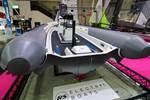
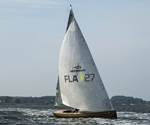
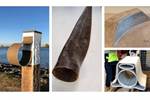
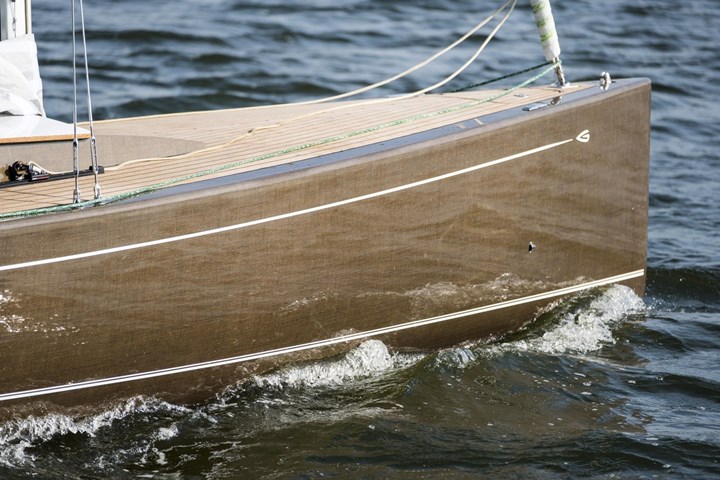






.jpg;maxWidth=300;quality=90)











